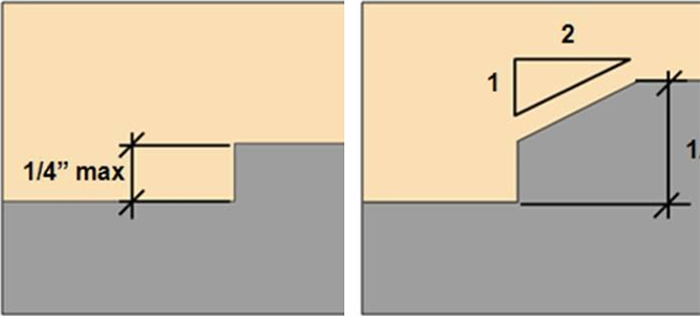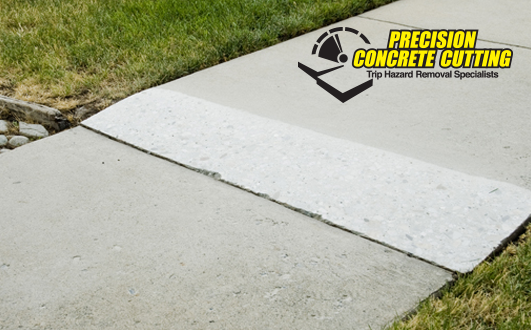Sidewalk ADA Compliance – Did you know there is a Federal law against having a trip Hazard on your sidewalk greater than ¼? The low cost of having it repaired is far less than a trip and fall lawsuit.
Let’s face it people trip they fall and they sue for the past 10 years we stayed cities Communities In Schools and universities hundreds of thousands of dollars in Law Suites.
Precision Concrete Cutting is your solution using our patented saw cutting technology we eliminate trip hazards on sidewalks Precision Concrete Cutting 866-792-8006.
The Americans with Disabilities Act (ADA) of 1990 defines a ‘trip hazard’ as any vertical change of over 1/4 inch or more at any joint or crack. Since the ADA demands strict compliance, trip hazards represent a legal liability to our clients. Cities, school districts, hospitals, private communities, shopping malls, universities, apartment complexes, and other property owners are all extremely concerned with this liability.
Changes in Level
Changes in level can be up to ¼” without treatment or ½” if beveled with a slope no steeper than 1:2. Changes in the level above a ½” must be treated as a ramp or curb ramp (or a walkway if a slope no steeper than 1:20 can be achieved). These specifications apply to all portions of accessible routes, including thresholds and carpet trim.
1/4” Max Change in Level 1/2” Max Change in Level

Must accessible surfaces be paved?
Concrete, asphalt, and other paved surfaces are more reliably compliant, but other materials, such as wood, and construction methods can be used to provide firm and stable surfaces. Loose material like gravel will not perform adequately unless it is sufficiently stabilized by binders, compaction, or other treatments and will likely require repeated maintenance.
What is the minimum level of slip resistance required by the standards?
The standards require ground and floor surfaces to be slip-resistant, but they do not specify a minimum level of slip resistance or the coefficient of friction. This value varies according to the measurement method and protocols used. Some products are labeled with a rated level, but in the absence of a consensus test procedure, the standards do not set a minimum value.
Standard methods to prevent or minimize slipperiness in the specification of floor materials, textures, applications, and finishes may be sufficient for compliance with the standards.
Is there a minimum distance between changes in level?
The standards do not require a minimum horizontal separation between changes in the level of a ½” or less. Such level changes may need to be in close proximity, such as at raised thresholds (otherwise a minimum 48” separation will provide enough wheelchair space so that only one vertical change is negotiated at a time). Ramps and curb ramps, which must be used to span vertical changes greater than ½”, must have level landings and clearances at the tops and bottoms of each run to provide adequate separation and resting intervals between sloping surfaces.
Elongated surface openings must be perpendicular to the dominant direction of travel, but what if there is no dominant direction of travel?
When there is no dominant direction of cross-traffic, openings must be limited to ½” in both dimensions. Where space allows accessible routes to completely bypass the area with openings, elongated openings can be oriented in either direction.
Sidewalk ADA Compliance
Related Articles
Sidewalk Repair Trip Hazard in San Francisco
Sidewalk Repair San Francisco CA
Sidewalk Trip Hazard Repair San Francisco

